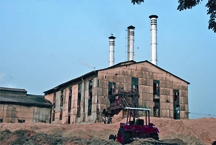Sugar Industry
Sugar Industry From very ancient times Bangladesh has been growing sugarcane for making gud or sukker or khandeswari. Such sweeteners are also produced from date and palm juice. Bengal was well known for quality sugar in the 16th century. The east india company exported large quantities of sugar from Bengal every year. The volume was 820,186 maunds (1 maund = 37.65 kg) in 1795 and 3,324,168 maunds in 1805. Production of beet sugar caused decline in production of cane sugar towards 1840. Later, the sugar industry suffered seriously due to diversion of land to jute.

Under British rule, India could not produce enough sugar to meet demands of the domestic market although it continued to export it under colonial circumstances, largely to European countries. The gap was met by import mainly from Java. In 1947, East Pakistan inherited only a few sugar mills located at Rajshahi (Gopalpur), Dinajpur (Setabganj), Kushtia (Darshana), Dhaka (Chittaranjan and Arikhola), and Mymensingh (Kishoreganj). The total cane crushing capacity of these mills was only 4,350 metric tons. In 1947, sugarcane occupied less than 1 percent of the cropped area. The East Pakistan Industrial Development Corporation planned to establish 10 new sugar mills to raise production capacity to 1 million metric tons. But by 1956, only 5 mills could be established and the production stood at only 26,000 metric tons.
Sugar industry plays an important role in the economy of Bangladesh by way of farming and creation of employment. The industry is under the Bangladesh Sugar and Food Industries Corporation (BSFIC). By-products of sugar mills have many uses. Molasses and bagasse are inputs for other industries. Around 425,000 acres of land are under sugarcane and the annual production is about 7.5 million tons, of which only 2.28 million tons are used in sugar mills and the rest goes to molasses making. Bangladesh now produces about 150,000 tons of sugar, 100,000 tons of molasses and 800,000 tons of bagasse per year. The country, however, ranks the lowest in the world in per acre yield of sugarcane - only 15 tons, while the comparative figures for Cuba, Indonesia, Australia and Hawaii are 36, 45, 55 and 70 tons respectively. Recovery of sugar from cane is also the poorest in Bangladesh - only 7.4% compared to 9% in Indonesia, 12.3% in Cuba, 12.4% in Hawaii and 15.6% in Australia.
In the 1980s, the industry employed 15% of the labour force and had 30% of the fixed assets of the food industry as a whole. With 1.5% of world production, Bangladesh ranked 67th among the 130 sugar producing countries. In 2012, the country has 15 sugar mills at Panchagarh, Thakurgaon, Setabganj, Rangpur, Shyampur, Rajshahi, Mahimaganj, Jaipurhat, Darshana, Kushtia, Mobarakganj, Jamalpur, Kaliachapra, Narsingdi, and Pabna. The estimated total annual production capacity of these mills was about 215,000 tons but the mills did not work in full capacity and, therefore, the production remained far less than the country's total estimated annual demand of about 400,000 tons.
The total harvesting season between 1972 and 2009 is 34, of which sugar production faced damage of 20 and profit of 14 seasons. The demand of sugar is 12-14 lacs metric tons per year in the country. It is claimed that the production capacity of 15 state owned sugar mills is 2.15 lacs metric tons. But apparently the mills can produce less than 1 lac metric tons.
During the crushing season of 2011-2012, the cane cultivation covered an area of 1,69,000 acres of land with a production of about 40 lacs tons. With deduction of nearby 10 lacs tons cane (for chewing consumption and grafting preservation), about 30 lacs tons should go to the sugar mills for manufacture of sugar. But less than 50% of the cultivated cane normally supplied to the mills. It is mainly for the high price of gur in the market and the complexities in getting payment of the supply of sugarcane to the mills.
Sugar might be an export commodity and Bangladesh can earn foreign currency provided that following measures are taken, such as modernisation of mills, full fledged cane cultivation, lending of money to cane growers on easy terms, permission to refineries in full capacity production, modern technology and use of modern equipments in cane cultivation and sugar production, prevent equipment and system loss, malpractices of mill staff and proper and extensive use of by-products of sugar mills. [M Habibullah and Gazi Md Mizanur Rahman]
